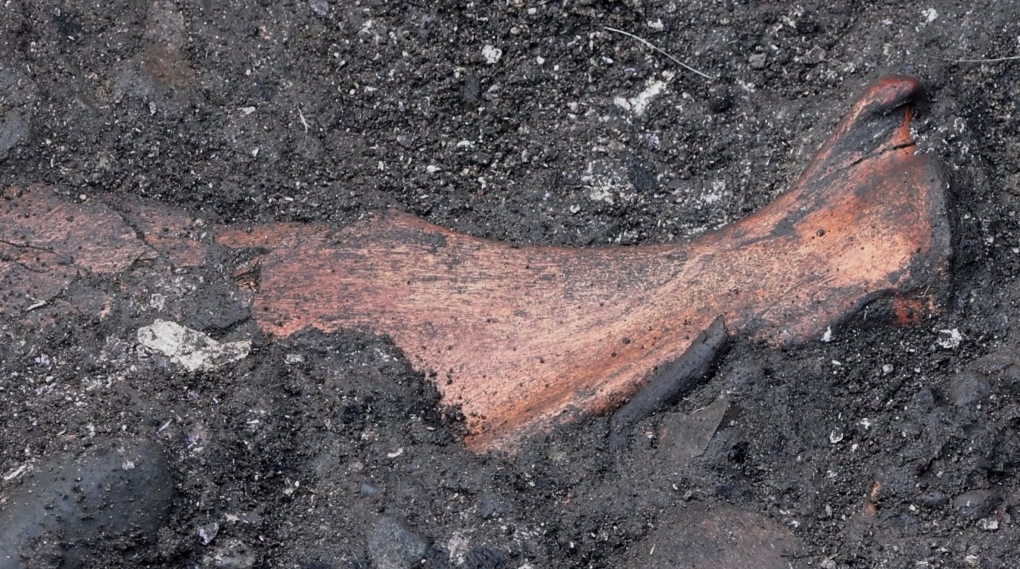Saanich archaeological dig reveals centuries of Indigenous history
At Agate Park in Cordova Bay, history is being revealed. Generations of First Nations' oral history has been confirmed at a thriving community that once was.
“We’re at the ancient village site of ȾEL¸IȽĆE,” said Brian Thom, associate professor of anthropology at the University of Victoria, who is leading the three-week dig.
“[We're] going through the layers and levels of the soils, finding everywhere we look the footprint of the old village that sat here for 1,000 years,” said Thom.
The dig is a partnership between the University of Victoria and a number of local First Nation communities.
“It’s very emotional for me,” said Roger Charlie, a Tsartlip First Nation band member.
Charlie has been told stories his whole life from elders about the vibrancy of this nearly forgotten village.
“About big feasts that used to be here and all the canoes that used to be lined up down here,” said Charlie.
Around two dozen people have been working the site, finding shell middens, as well as fishing and hunting tools.
“This is an elk tooth,” said Kaia Carr-Mehan, a third-year anthropology student at the University of Victoria.
Evidence was uncovered of a once abundant elk population on southern Vancouver Island.
“We have a large, like a shocking large, amount of elk remains at this site,” said Carr-Mehan.
Within one particular hole the team has just discovered a shoulder bone from one of those elk.
It’s thought the village once housed a population of around 250 people – a population that worked the entire geographical area.
“Just that short paddle down the way is where people had a very productive fish trap,” said Thom, pointing south along the beach.
 An elk shoulder bone discovered at the Saanich dig site. According to evidence gathered throughout the three-week dig, southern Vancouver Island once had a thriving elk population. (CTV News)
An elk shoulder bone discovered at the Saanich dig site. According to evidence gathered throughout the three-week dig, southern Vancouver Island once had a thriving elk population. (CTV News)
The beginning of July saw extremely low tides, revealing a first for the region.
“We did the first documentation of a fish trap in the South Island area,” said Thom. “It was very exciting.”
“I feel very honoured to be invited here,” said Darian Claxton, a Tsawout First Nation band member.
Over the past three weeks, he has discovered he has greater ties to the dig site than first imagined.
“My Auntie Belinda’s mother Elcie Claxton was actually from this village site,” said Claxton.
The dig is a picture frozen in time, a village colonial records show disappeared around 1870.
The excavation ended on Wednesday.
“There are more questions to answer but that will be for a future day,” said Thom.
What the dig has revealed is a better understanding of the people who once called Cordova Bay home and how they thrived for more than 1,000 years.
CTVNews.ca Top Stories

B.C. RCMP still accepting tips on family’s disappearance 35 years ago
Mounties in Prince George say they’re still looking for help from the public to figure out what happened to a family that disappeared more than three decades ago.
Donald Trump faces new U.S. indictment in election subversion case
U.S. prosecutors obtained a new indictment in the 2020 election subversion case against Donald Trump on Tuesday.
What research has uncovered about the Shroud of Turin
Research has uncovered evidence that may strengthen the case for the authenticity of the famous Shroud of Turin amid conflicting theories that the linen cloth is a medieval forgery.
Summer snow just fell on a B.C. highway
It’s still summer, but snow was falling on a highway in B.C.’s Interior Tuesday afternoon.
Ontario woman denied lottery jackpot after forgetting where she bought ticket
When an Ontario woman found out she won the lottery playing Lotto 649, she said she was excited to collect her prize of $1,003, but that excitement quickly turned to frustration when she couldn't collect her winnings.
More humid than usual? It might be the corn
The process of 'evapotranspiration' or 'crop sweat' is a major contributor to rising humidity levels, according to a senior climatologist.
Pizza Hut is offering a pizza box that folds into a table
Pizza Hut is offering a special pizza box that turns into a miniature table with an order of a large regular-priced pizza in Dallas, Texas; Charlotte, North Carolina; and Orlando, Florida. Pizza Hut said it chose those cities based off a Penske Truck Rental list that ranked the cities among the country’s top moving destinations.
U.S. becoming more protectionist, former ambassador warns Trudeau cabinet
Canada's former ambassador to the United States warns that our country could be dealing with a more protectionist trade partner, regardless of who wins the presidential election.
Flexible ticket rebooking coming for Air Canada flyers
Air Canada said it would offer flexible rebooking of tickets to its flyers, owing to uncertainty associated with a possible pilots strike at the end of a 21-day cooling off period that begins on Tuesday.

































